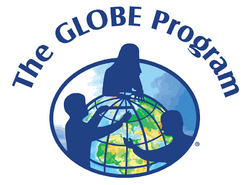Organization:GLOBE Program
 | |
| Founded | 1995 |
|---|---|
| Type | International organization |
| Focus | environmental education, scientific research |
| Location |
|
Area served | Worldwide |
| Website | www |
The Global Learning and Observations to Benefit the Environment (GLOBE) Program is a worldwide hands-on, science and education program focusing on the environment, now active in over 120 countries worldwide.[1] It works to promote the teaching and learning of science, enhance environmental literacy and stewardship, and promote scientific discovery. Students and teachers collect data and perform research in collaboration with scientists from numerous international agencies, and their work is made accessible through the GLOBE website.[2]
Background
The GLOBE Program seeks to teach young students experimental skills using real experiments and equipment. Students, teachers, and scientists collaborate in a unique global learning network.[3]
The program is housed by the University Corporation for Atmospheric Research (UCAR) in Boulder, Colorado, and sponsored by NASA (National Aeronautics and Space Administration[4]), NOAA (National Oceanic and Atmospheric Administration[5] ), and the National Science Foundation,[6] through an inter-agency agreement signed in 1998.[7] The U.S. Department of State supports the work of the GLOBE Program internationally (see for example the agreement with Mexico[8]); many other organizations support the GLOBE Program in the US and around the world.
Mission
The GLOBE Program's Mission is to promote the teaching and learning of science, enhance environmental literacy and stewardship, and promote scientific discovery.[9]
Specific goals include:
- Improve student achievement across the curriculum with a focus on student research in environmental and Earth system science;
- Enhance awareness and support activities of individuals throughout the world to benefit the environment;
- Contribute to scientific understanding of Earth as a system;
- Connect and inspire the next generation of global scientists; and
- Get young minds outside to explore new things.
History
- 1995: The GLOBE Program launched by former US vice-president Al Gore on Earth Day, April 22[10]
- 1997: GLOBE Teacher Conference held in the US
- 1998: 1st GLOBE Learning Expedition (GLE) held in Finland
- 2000: 2nd GLE held in the US
- 2003: 53 protocols across atmosphere, biosphere, hydrosphere, and soil (pedosphere)
- 2003: 3rd GLE held in Croatia
- 2003: NASA selected the University Corporation for Atmospheric Research (UCAR), to operate The GLOBE Program Office
- 2005: Earth Day; GLOBE celebrates its 10th birthday with 15,000 schools in 106 countries
- 2008: 4th GLE held in South Africa
- 2009: 20 million data in the global database
- 2011: Student Climate Research Campaign launches[11]
- 2014: 1st regional student aerosols research campaign led by Europe and Eurasia; Global Precipitation Measurement (GPM) and Soil Moisture Active Passive (SMAP), student research campaigns with NASA launched
- 2014: 5th GLE held in India
- 2014: NASA selected the University Corporation for Atmospheric Research (UCAR) to operate The GLOBE Implementation Office
- 2015: Earth Day, GLOBE celebrates its 20th birthday; GLOBE launches new data entry app for schools, an enhanced website, and an updated teacher's guide; 51 protocols in the Program; 128 million data entries in the international database[12]
- 2016: GLOBE provides online eTraining; hosts International Virtual Science Fair and six regional U.S. science fairs, and various student scientific campaigns
- 2016: Launch of GLOBE Observer app[13]
- 2017: Data reaches over 140 million measurements; International Virtual Science Symposium increases in number of submitted projects and worldwide representation, and new mosquito protocol
- 2018: 6th GLE held in Ireland
Activities for learning
The GLOBE Program provides the opportunity for students to learn by taking scientifically valid measurements in the fields of atmosphere, hydrology, soils, land cover, and phenology, depending upon their local curricula. Students report their data through the Internet, create maps and graphs to analyze data sets, and collaborate with scientists and other GLOBE students around the world. All the GLOBE data and observations are in the public domain.
Contribution by scientists
Members of the international science community are involved in the design and implementation of the GLOBE Program. Scientists are involved in helping select GLOBE environmental measurements, developing measurement procedures, and ensuring overall quality control of data. This is important to ensure that other scientists have confidence about these results and their findings. Their continued support and direction helps to ensure that GLOBE environmental measurements make a significant contribution to the global environmental database.
See also
- GLOBE at Night
References
Notes
- ↑ "About". GLOBE.gov. 2012-06-28. http://globe.gov/about.
- ↑ globe.gov
- ↑ Baker, Amanda (19 September 2017). "The GLOBE Program: Making the Case for K–12 Citizen Scientists" (in en). Scientific American Blog Network. https://blogs.scientificamerican.com/budding-scientist/the-globe-program-making-the-case-for-k-12-citizen-scientists/.
- ↑ "Global Learning & Observations to Benefit the Environment". Education.ssc.nasa.gov. 2012-01-30. http://education.ssc.nasa.gov/globe.asp.
- ↑ [1]
- ↑ "Funding - Global Learning and Observations to Benefit the Environment - US National Science Foundation (NSF)". nsf.gov. https://www.nsf.gov/funding/pgm_summ.jsp?pims_id=5466.
- ↑ "Interagency Agreement" (PDF). https://science.nasa.gov/media/medialibrary/2010/03/31/NOAA-NSF-NASA-IA-GLOBE_Program_Support-980407.pdf.
- ↑ United States Department of State
- ↑ [2]
- ↑ Nussbaum, Debra (June 4, 1998). "Global Weather Project Unites Students on Web". New York Times. https://www.nytimes.com/1998/06/04/technology/global-weather-project-unites-students-on-web.html.
- ↑ "SCRC". GLOBE.gov. 2012-06-28. http://globe.gov/scrc.
- ↑ Howell, Elizabeth (22 April 2015). "How to Celebrate Earth Day 2015 with NASA" (in en). Space.com. https://www.space.com/29173-celebrate-earth-day-2015-nasa.html.
- ↑ Shepherd, Marshall. "How You And The Kids Can Use A Cellphone To Help NASA Study Clouds" (in en). Forbes (28 March 2018). https://www.forbes.com/sites/marshallshepherd/2018/03/28/how-you-and-the-kids-can-use-a-cellphone-to-help-nasa-study-clouds/?sh=11f27833594d.
Additional sources
External links
- Regional sites
- Africa Region
- Asia-Pacific Region
- Europe-Eurasia Region
- Latin America-Caribbean Region
- Near East-North Africa Region
- North America Region
- Australia
- Japan
 |


